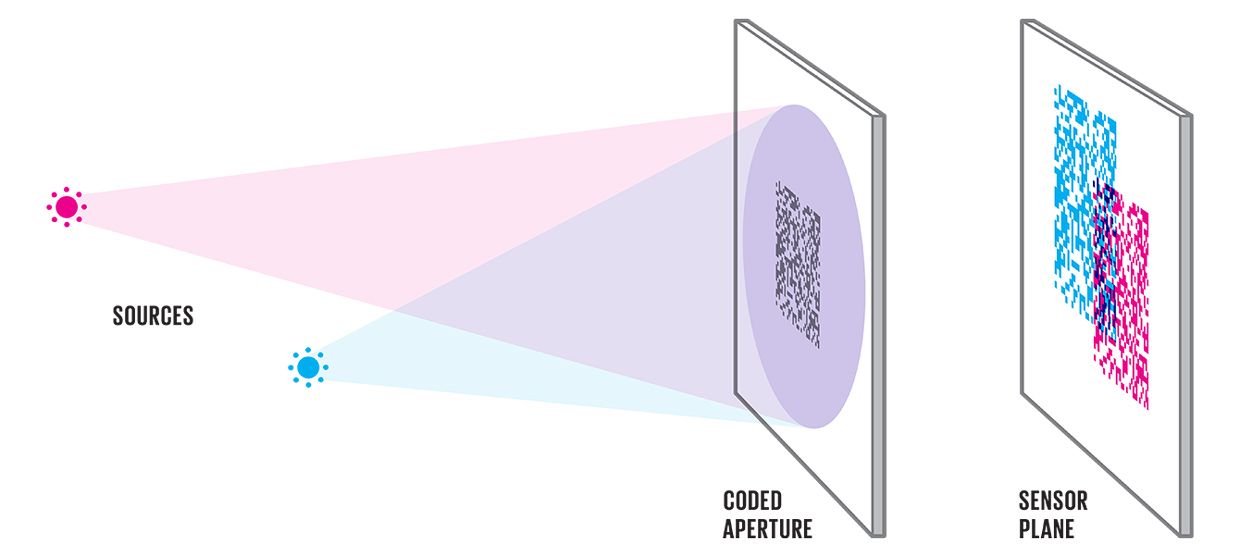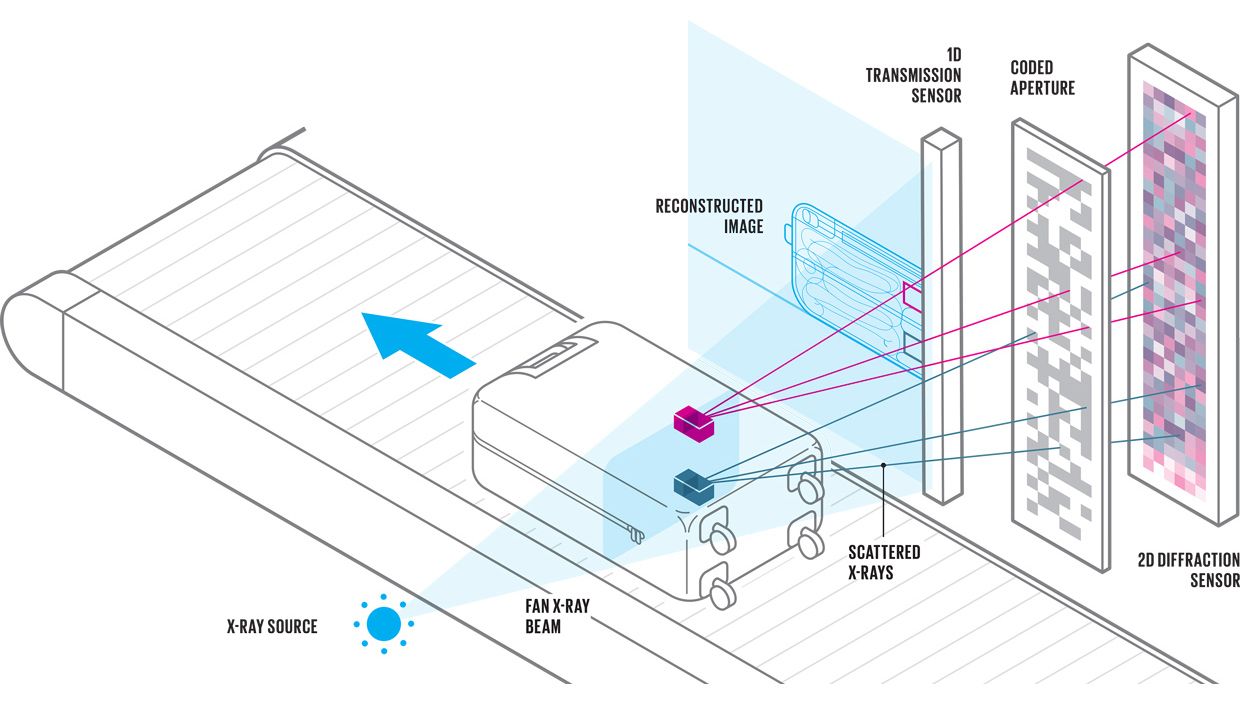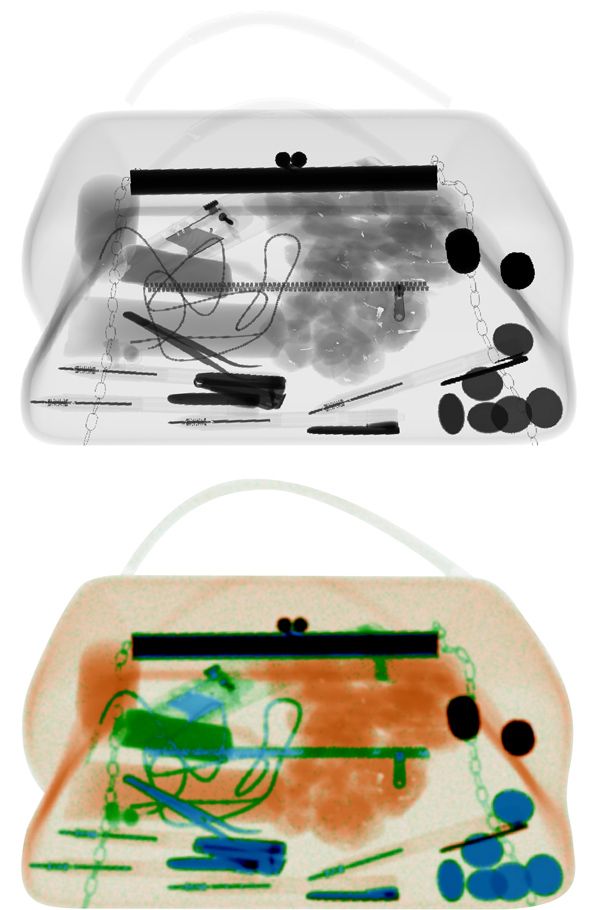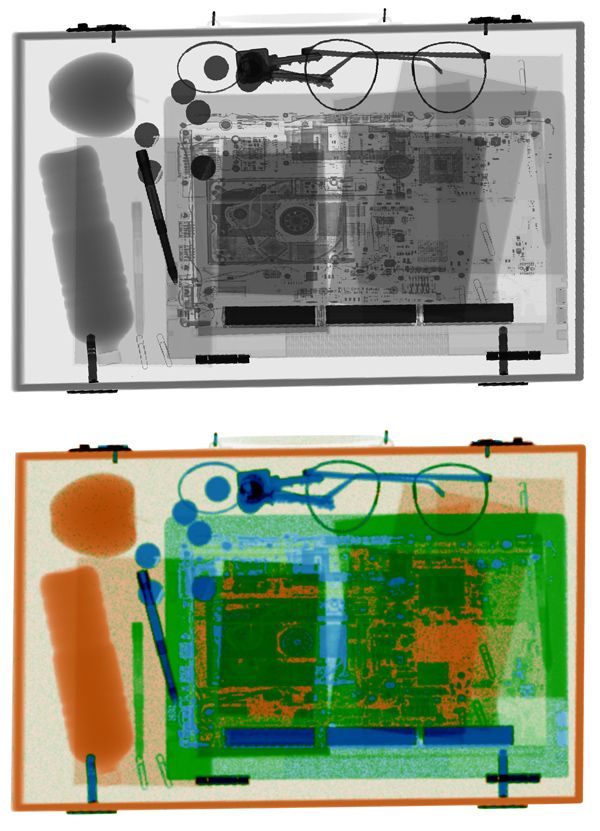Future Baggage Scanners Will Tell Us What Things Are Made Of
 Image: David Arky
Image: David Arky Some years ago, the three of us found ourselves together in a very long security line at Reagan National Airport in Washington, D.C. Maybe, we joked, Superman could use his X-ray vision to help out the beleaguered Transportation Security Administration (TSA) employees and the traveling masses.
After an oddly technical discussion about our favorite superhero, we agreed that the Man of Steel's X-ray vision wouldn't really be able to tackle this particular challenge. That's because some concealed threats don't reveal themselves directly in an X-ray image, and finding them with X-rays would require computational processing far beyond what even Superman's brain could manage. But then came an exciting realization: We did have the power to solve the technical problem here. By employing our combined expertise, we began developing an X-ray system well suited for detecting such dangerous objects hidden in a carry-on bag. Perhaps one day it will shorten the kind of line we were standing in.
The goal of aviation security is, of course, to make sure that dangerous items do not end up on planes-while also providing an acceptable passenger experience. What exactly this experience should be depends on whom you ask, but it likely includes short, quick-moving lines and the capacity to bring everything you want without having to rummage through your bag to exonerate your electric toothbrush.
To make this vision a reality, the TSA would need a device that is capable of rapidly scanning the many bags passing through a security checkpoint and deciding on its own whether any of them contains a threat. Today's standard approach uses X-ray projection imaging, the same technology doctors use to diagnose broken bones.
X-ray projection imaging works by directing these penetrating rays at something and measuring how much energy comes out the other side. In other words, the TSA's scanners sense the X-ray shadows cast by the objects in your suitcase. The shape and degree of darkness of the shadows are used to distinguish between different items or, in the case of medical imaging, to reveal a fracture in a bone.
While this strategy works reasonably well, anyone who has played shadow puppets knows that shadows are not always what they appear to be. That's why more advanced scanners use computed tomography, which combines X-ray transmission images obtained from many angles to yield the full 3D shape of objects within your bag. This tactic provides significant advantages, such as allowing you to leave most items (laptops, iPads, keys, and so forth) in your bag for a single scan.
Such advanced scanners are now being deployed at U.S. airports, although plenty of older scanners are still in use. Their 2D images are interpreted by a combination of computer algorithms and trained operators, who then determine whether you are free to continue to your plane or need to have your carry-on more carefully inspected by an agent.
In general, this system works great for shape-based threats such as guns or knives. While we can debate whether a small penknife or knitting needle could really be used as a weapon, these transmission X-ray scanners detect such objects routinely. And more recent enhancements, such as deep-learning-based image-recognition algorithms, allow automatic identification of a variety of such dangerous items.
 Photo: John Greim/Light Rocket/Getty Images An Airport Ritual: Airline passengers have long had to suffer excessive wait times at security checkpoints, as in this scene from Denver International Airport in 2016. They will no doubt have to endure the same when travel levels recover if better scanning technology doesn't become available.
Photo: John Greim/Light Rocket/Getty Images An Airport Ritual: Airline passengers have long had to suffer excessive wait times at security checkpoints, as in this scene from Denver International Airport in 2016. They will no doubt have to endure the same when travel levels recover if better scanning technology doesn't become available. This is all well and good, but what if the shape of some potential threat doesn't reveal its dangerous nature? After all, an explosive could be fashioned into the shape of a common, benign object. And this isn't just a hypothetical-a number of plots from around the world have centered around shaping explosives like everyday objects or hiding them in innocuous places such as within bottles of liquor or contact-lens cleaner or tucked away in laptops or shoes. How can the TSA deal with those threats? The answer is to look beyond the item's shadow and to examine instead what we might call its material fingerprint.
It has been known for more than a century that X-rays can reveal the atomic structure of a material through a process known as X-ray diffraction. For this, you have to measure the rays that bounce off the atoms or molecules in the target and ricochet in different directions. How the X-rays scatter depends on the details of the material's interatomic spacing and degree of crystallinity.
X-ray diffraction can, for example, easily distinguish among coal, graphite, and diamond, despite the fact that these substances are chemically identical-they are all made up of carbon. It can even identify different liquids, which lack crystallinity but have different interatomic spacings as a function of molecular size and repulsion. So a scanner based on this technique could, for example, determine whether the bottle someone stuffed in his carry-on was filled with water or with nitroglycerine.
Making use of X-ray diffraction measurements, however, is a thorny technical problem. To begin with, the diffracted signal is several orders of magnitude weaker than the transmitted signal. So it's harder to measure at all. It's also much harder to interpret. As a result, even though such fingerprinting (more properly called X-ray diffraction tomography) would pretty much guarantee success in identifying threats, the technology required has in the past come at a significant cost, not just financially but also in terms of complexity, scan time, and other factors.
The focus of our efforts over the last few years has been figuring out how to combine X-ray diffraction measurements with traditional transmission imaging in a practical way. We're not done yet, but we've gotten pretty far in the development of what we expect to be the next generation of airport baggage scanners.
For more than 30 years, researchers have attempted to use X-ray diffraction to map out differences in atomic structure from place to place within an extended object. There's been some progress, particularly in the medical and materials-science communities, but the systems built for this have been complicated, expensive, and slow. That's why systems based on these principles are not yet scanning bags at airports.
Virtual Bags To aid in designing a new and more capable generation of baggage scanners, the authors conducted detailed numerical simulations of the physical processes that take place within a traditional baggage scanner. These virtual bags contain a variety of ordinary objects. In two of the images, the resolution has been degraded and false colors applied so that the results mimic the appearance of images obtained by actual scanners.The dimness of the diffracted signals is an issue, to be sure, but one that's relatively straightforward to address. First, you need a strong source of X-rays, which might be dangerous in a medical setting but really isn't a problem for a baggage scanner. Second, the image sensor you use also has to be more sensitive than is typical, but again that's not hard to arrange. The much more vexing problem is that the diffracted signals originate from all points in the bag. And each pixel of your detector records all these different signals at once.
The trick to disentangling these overlapping signals-so you can tell which of the scattered X-rays came from your laptop and which from your water bottle, say-involves placing an additional element in the system, one that affects the X-ray signals in a controlled way. This element, called a coded aperture, is basically a slab of highly absorptive material with a set of holes drilled in it. Those holes are arranged in a specific pattern. X-rays can pass through the holes but are blocked by the absorptive material.
The reason for using such a coded aperture is easier to understand with the help of a thought experiment. Imagine that the piece of luggage being scanned is composed of hundreds of tiny X-ray sources, each of which can be switched on and off on command. If you turn on just one source, the X-rays it emits will pass through the holes in the coded aperture and continue on to the image sensor positioned some distance behind it. If you had Superman's X-ray vision, you'd see a pattern of spots projected onto the plane of the image sensor.
Now switch on a different one of these tiny X-ray sources instead, one located at a different position in the bag. The pattern of spots projected on the image plane will now be different. The spots will be bigger or smaller and located in different places. The same principle applies to shadow puppets, whose shadows change in size and position depending on where the puppet is located with respect to the light source and the wall.
So the coded aperture affects the X-rays originating from each different location within the bag in a unique way, which is akin to tagging them with a bar code. This works even though the X-rays originating from different regions in the bag impinge on the detector at the same time. It takes some clever calculations, but the signals generated by X-rays passing through the coded aperture and arriving at the detector can be untangled, allowing the scanner to distinguish the X-rays coming from different parts of the bag. This process is much easier if the scanner also captures the traditional X-ray transmission images, which give you a pretty good idea of where the relevant objects are positioned in the bag.
Using this coded-aperture approach, we previously built what we'll call a preprototype scanner, which had a simple configuration and used inexpensive off-the-shelf components. With it, we were able to identify different plastics, liquids, and solids at a resolution of better than 1 centimeter.
Taking this to the next level involves designing a scanner that fully combines transmission and X-ray diffraction measurements and employs state-of-the-art detectors. It should be considerably faster, more accurate, and less expensive than what we've built before. This scanner should be suitable for commercialization and use in airports around the world.
To understand the possibilities of this and related systems, we required detailed numerical simulations, which helped us to compare possible configurations and to identify the best ones. As a first step in making such evaluations, we developed software that let us create virtual bags in a fully automated manner. Running it with enough computing horsepower-either locally on high-performance clusters or using suitable cloud resources-allows us to create hundreds, thousands, or even millions of virtual bags, ones that are representative of the kinds of things travelers carry to the airport every day. We can now run those virtual bags through our simulation software, which models the relevant X-ray physics (for both transmission and scattering) and spits out high-fidelity estimates of the measurements you would get with a scanner of a particular design.
A Scattered Approach to Baggage Scanning The authors' apparatus measures both the attenuation of X-rays transmitted through the bag being scanned and X-rays scattered in different directions when they strike objects inside the bag.
To distinguish scattered X-rays coming from different positions within the bag, the authors' prototype baggage scanner includes a coded aperture-essentially a screen with a random pattern of openings that allow only some X-rays to pass through it. Coded apertures are also used in various optical devices.
The pattern of light or X-rays that a source projects through the coded aperture onto the sensor plane depends on the position of that source. Here, the more distant red light projects a pattern that is smaller than the blue one and offset from it. The light falling on the sensor plane can be analyzed to reveal the location and intensity of each source.

The authors' scanner employs a coded aperture in front of a sensor plane that is offset from the X-ray beam. That offset allows this two-dimensional sensor to register the faint X-rays scattered off of various objects within the bag without being overwhelmed by radiation from the main, fan-shaped beam. The attenuation of that beam is measured by a one-dimensional sensor positioned in the plane of the beam.
Measurements of X-ray attenuation allow the scanner to produce a traditional X-ray image of the bag. By analyzing the scattered X-rays, the scanner can also determine the material composition of objects within the bag and label them as either benign or threatening.
The ability to generate many controllable, ultrarealistic virtual scans for arbitrary system configurations has allowed us to quantify how much better one scanner design is compared with another and what the fundamental detection performance of a given type of measurement would be. As a side benefit, this same software lets us generate data sets for training and validating the machine-learning algorithms the scanners will run to recognize images and detect threats.
So even as new computed-tomography baggage scanners continue to roll out at airports across the United States, we will be working to pave the way for an entirely new kind of scanner, one that can identify a dangerous item based on its material-specific fingerprint, not just the type of X-ray shadows it casts.
We are thrilled at the prospect of being able to contribute to improved security in an industry that is so critical to the operation of the modern world. We are so committed to making a difference that we joined with colleague Anuj Kapadia of the Duke University radiology faculty to establish Quadridox, a company focused on turning our security-line musings into real-world solutions. And it may even turn out that X-ray diffraction has a future beyond baggage scanning. The ability to identify specific materials will most likely prove useful for other applications, too, such as the detection of illicit drugs in the mail, perhaps even in the diagnosis of cancer. At the end of the day, though, we would settle for a future where the only reason you have to open your bag at an airport checkpoint is to take a sip from your water bottle.
This article appears in the July 2020 print issue as The All-Seeing Baggage Scanner."
About the AuthorsJoel Greenberg and Michael Gehm are with the department of electrical and computer engineering at Duke University. Greenberg is an associate research professor and Gehm is an associate professor. Amit Ashok is an associate professor of optical sciences at the University of Arizona.

